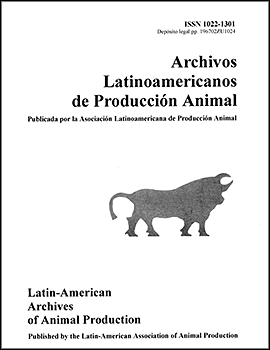
|
Archivos Latinoamericanos de Produccion Animal
Asociacion Latinoamericana de Produccion Animal
ISSN: 1022-1301
EISSN: 1022-1301
Vol. 16, No. 1, 2008, pp. 7-12
|
 Bioline Code: la08003
Bioline Code: la08003
Full paper language: Spanish
Document type: Research Article
Document available free of charge
|
|
|
Archivos Latinoamericanos de Produccion Animal, Vol. 16, No. 1, 2008, pp. 7-12
| en |
Influence of organic or inorganic selenium in diets on in situ drymatter degradability and ruminal kinetics in sheep
Arzola, C.; Segovia, J.; Ruiz, O.; Salinas-Chavira, J.; Rodriguez-Muela, C. & Jiménez, J.
Abstract
This study assessed the in situ dry matter (DM) degradability and ruminal kinetics of the solid and liquid fractions of diets with two selenium sources (inorganic and organic), using three Pelibuey lambs (45 ± 2 kg) with permanent rumen cannulae. Two treatments were used: basal diet plus inorganic selenium (IS), and basal diet plus organic selenium Sel-Plex 50? (OS). The statistical analysis used the model of two compartments and two independent rates (G4G1) with non-linear regression (PROC NLIN of SAS) and mean comparison. The results showed no differences (P>.05) for DM degradability, however the degradation parameters (a, b and a+b) were different (P<.05) in favor of IS. In contrast, the degradation rate (c) was higher for OS. The solid fraction kinetics showed differences (P<.05) in slow (k1) and fast (k2) flow rates; also there were statistical differences in fecal matter (FM) output favoring OS, but no differences (P>.05) were observed in mean retention time in slow (MRTC1) and fast (MRTC2) compartments or in total mean retention time (TMRT). The kinetics of the liquid fraction showed differences (P<.05) in all parameters in favor of OS. In conclusion, the selenium source modifies ruminal parameters, which were better for organic selenium.
Keywords
In situ, degradability, kinetics, selenium source, sheep.
|
| |
| es |
Influencia del selenio orgánico o inorgánico en dietas sobre ladegradabilidad in situ de la material seca y cinética ruminal en ovinos
Arzola, C.; Segovia, J.; Ruiz, O.; Salinas-Chavira, J.; Rodriguez-Muela, C. & Jiménez, J.
Resumen
El presente estudio valoró la degradabilidad in situ de la material seca (MS) y cinética ruminal de las fracciones sólida y liquida de dietas con dos fuentes de selenio (inorgánico y orgánico), usando tres ovinos Pelibuey (45 ± 2 kg) con cánulas permanentes de rumen. Se usaron dos tratamientos: dieta basal mas selenio inorgánico (SI), y dieta basal mas selenio orgánico Sel-Plex 50? (SO). Para el análisis estadístico se utilizó el modelo de dos compartimentos y dos tasas independientes (G4G1) con regresión no lineal (PROC NLIN de SAS) y comparación de medias. Los resultados no mostraron diferencia (P>.05) para la degradabilidad de MS, sin embargo los parámetros de degradación (a, b y a+b) fueron diferentes (P<.05) en favor de SI. En contraste, la tasa de degradación (c) fue mayor para SO. La cinética de la fracción sólida mostró diferencias (P<.05) en las tasas de pasaje lenta (k1) y rápida (k2); también se encontraron diferencias estadísticas en la salida de material fecal (MF) en favor de SO, pero no se observaron diferencias (P>.05) en el tiempo medio de retención en los compartimentos lento (TMRC1) y rápido (TMRC2). La cinética de la fracción líquida mostró diferencias (P<.05) en todos los parámetros en favor de SO. En conclusión, La fuente de selenio modifica los parámetros ruminales, los cuales fueron mejores para selenio orgánico.
Palabras-clave
In situ, degradabilidad, cinética, fuente de selenio, ovinos.
|
| |
© Copyright 2008 - ALPA. Arch. Latinoam. Prod. Anim.
Alternative site location: http://www.alpa.org.ve/ojs/index.php
|
|
